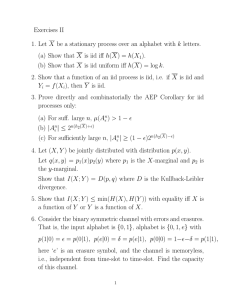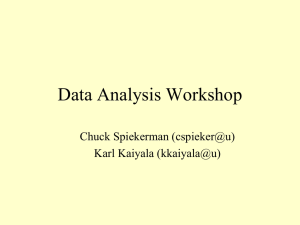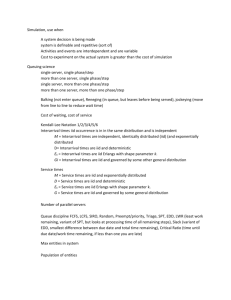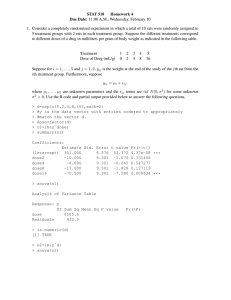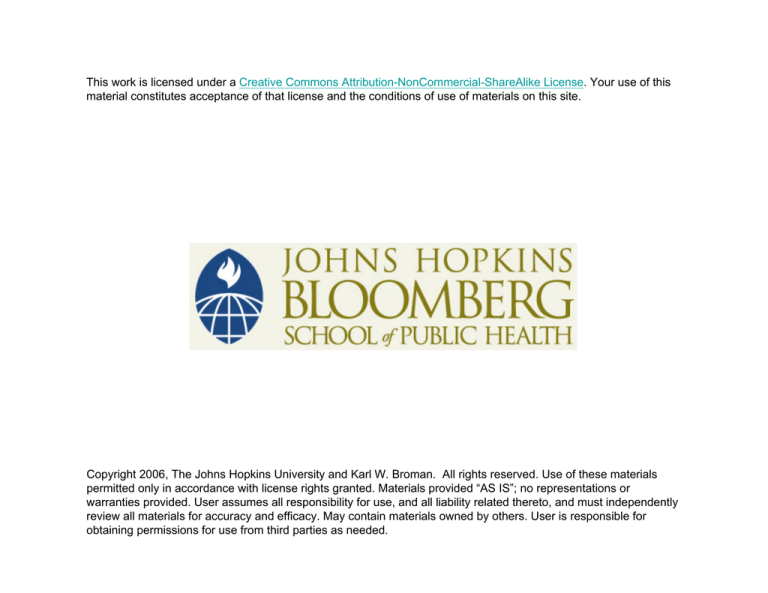
This work is licensed under a Creative Commons Attribution-NonCommercial-ShareAlike License. Your use of this
material constitutes acceptance of that license and the conditions of use of materials on this site.
Copyright 2006, The Johns Hopkins University and Karl W. Broman. All rights reserved. Use of these materials
permitted only in accordance with license rights granted. Materials provided “AS IS”; no representations or
warranties provided. User assumes all responsibility for use, and all liability related thereto, and must independently
review all materials for accuracy and efficacy. May contain materials owned by others. User is responsible for
obtaining permissions for use from third parties as needed.
pf3d7 and pyoelii
0.35
pf3d7
pyoelii
0.30
OD
0.25
0.20
0.15
0.10
0
10
25
50
H2O2 concentration
general
parallel
concurrent
coincident
pf3d7 and pyoelii
0.35
pf3d7
pyoelii
0.30
OD
0.25
0.20
0.15
0.10
0
10
25
50
H2O2 concentration
More than one predictor
#
1
2
3
4
5
6
7
8
9
10
11
12
13
14
15
16
17
18
19
20
21
22
23
24
Y
0.3399
0.3563
0.3538
0.3168
0.3054
0.3174
0.2460
0.2618
0.2848
0.1535
0.1613
0.1525
0.3332
0.3414
0.3299
0.2940
0.2948
0.2903
0.2089
0.2189
0.2102
0.1006
0.1031
0.1452
X1 X2
0 0
0 0
0 0
10 0
10 0
10 0
25 0
25 0
25 0
50 0
50 0
50 0
0 1
0 1
0 1
10 1
10 1
10 1
25 1
25 1
25 1
50 1
50 1
50 1
The model with two parallel lines can be described as
Y = β0 + β1X1 + β2X2 + ǫ
In other words (ur...equations):
(
β0 + β1X1 + ǫ
if X2 = 0
Y=
(β0 + β2) + β1X1 + ǫ if X2 = 1
Multiple linear regression
A multiple linear regression model has the form
Y = β0 + β1X1 + · · · + βkXk + ǫ,
ǫ ∼ N(0, σ 2)
The predictors (the X’s) can be categorical or numerical.
Often, all predictors are numerical or all are categorical.
And actually, categorical variables are converted into a group of
numerical ones.
ANOVA as linear regression
ANOVA:
k groups;
ni observations in group i
yi = response for individual i
gi = group to which individual i belongs
Model:
H0 :
Linear regression:
y’s indep’t; yi ∼ normal(µgi , σ 2)
µ1 = µ2 = · · · = µk
Let xij = 1 if individual i is in group j
(and = 0 otherwise).
Model:
yi = µ1xi1 + µ2xi2 + · · · + µkxik + ǫi
where ǫi iid ∼ Normal(0, σ 2)
You could also write...
yi = β1 + β2xi2 + · · · + βkxik + ǫi
In which case:
β1 = µ1
Here
βj = µj − µ1 for j > 1
H0 : µ 1 = µ 2 = · · · = µ k
is equivalent to
H0 : β2 = β3 = · · · = βk = 0
Estimation
We have the model
yi = β0 + β1xi1 + · · · + βkxik + ǫi,
ǫi ∼ iid Normal(0, σ 2)
We estimate the β ’s by the values for which
P
RSS = i(yi − ŷi)2 is minimized (aka “least squares”)
where ŷi = β̂0 + β̂1xi1 + · · · + β̂kxik
We estimate σ by
σ̂ =
s
RSS
n − (k + 1)
Trust me . . .
Calculation of the β̂ ’s (and their SEs and correlations) is not that
complicated, but without matrix algebra, the formulas are exceedingly nasty.
• The SEs of the β̂ ’s involve σ and the x’s.
• The β̂ ’s are normally distributed.
c (β̂)
• Obtain confidence intervals for the β ’s using β̂ ± t × SE
where t = quantile of t dist’n with n–(k+1) d.f.
c (β̂)
• Test H0 : β = 0 using |β̂|/SE
Compare this to a t dist’n with n–(k+1) d.f.
The example: a full model
x1 = [H2O2].
x2 = 0 or 1, indicating species of heme.
y = the OD measurement.
The model:
y = β0 + β1X1 + β2X2 + β3X1X2 + ǫ
i.e.,
y=
β0 + β1X1 + ǫ
(β0 + β2) + (β1 + β3)X1 + ǫ if X2 = 1
β2 = 0
−→
Same intercepts.
β3 = 0
−→
Same slopes.
β2 = β3 = 0
if X2 = 0
−→
Same lines.
Results
> lm.out <- lm(y ˜ x1 * x2, data=mydat)
> summary(lm.out)
Coefficients:
(Intercept)
x1
x2
x1:x2
Estimate Std. Error t value
0.35305
0.00544
64.9
-0.00387
0.00019
-20.2
-0.01992
0.00769
-2.6
-0.00055
0.00027
-2.0
Pr(>|t|)
< 2e-16
8.86e-15
0.0175
0.0563
Residual standard error: 0.0125 on 20 degrees of freedom
Multiple R-Squared: 0.98,Adjusted R-squared: 0.977
F-statistic: 326.4 on 3 and 20 DF, p-value: < 2.2e-16
Testing many β ’s
We have the model
yi = β0 + β1xi1 + · · · + βkxik + ǫi,
ǫi ∼ iid Normal(0, σ 2)
We seek to test
H0 : βr+1 = · · · = βk = 0.
In other words, do we really have just:
yi = β0 + β1xi1 + · · · + βrxir + ǫi,
?
ǫi ∼ iid Normal(0, σ 2)
What to do. . .
1. Fit the “full” model (with all k x’s).
2. Calculate the residual sum of squares, RSSfull.
3. Fit the “reduced” model (with only r x’s).
4. Calculate the residual sum of squares, RSSred.
5. Calculate F =
(RSSred−RSSfull)/(dfred−dffull)
.
RSSfull/dffull
where dfred = n − r − 1 and dffull = n − k − 1).
6. Under H0, F ∼ F(dfred − dffull, dffull).
In particular. . .
yi = β0 + β1xi1 + · · · + βkxik + ǫi,
ǫi ∼ iid Normal(0, σ 2)
We seek to test
H0 : β1 = · · · = βk = 0.
(i.e., none of the x’s are related to y.)
Full model:
All the x’s
Reduced model:
(i.e., y ∼ Normal(β0, σ 2)
P
RSSred = i(yi − ȳ)2
y = β0 + ǫ
P
P
P
F = [( i(yi − ȳ)2 − i(yi − ŷi)2)/k] / [ i(yi − ŷi)2/(n − k − 1)]
and compare to F(k, n – k – 1) dist’n.
The example
To test β2 = β3 = 0. . .
> lm.red <- lm(y ˜ x1, data=dat)
> lm.full <- lm(y ˜ x1*x2, data=dat)
> anova(lm.red,lm.full)
Analysis of Variance Table
Model 1: y ˜ x1
Model 2: y ˜ x1 + x2 + x1:x2
1
2
Res.Df
22
20
RSS
0.00975
0.00312
Df Sum of Sq
2
0.00663
F
Pr(>F)
21.22
1.1e-05


